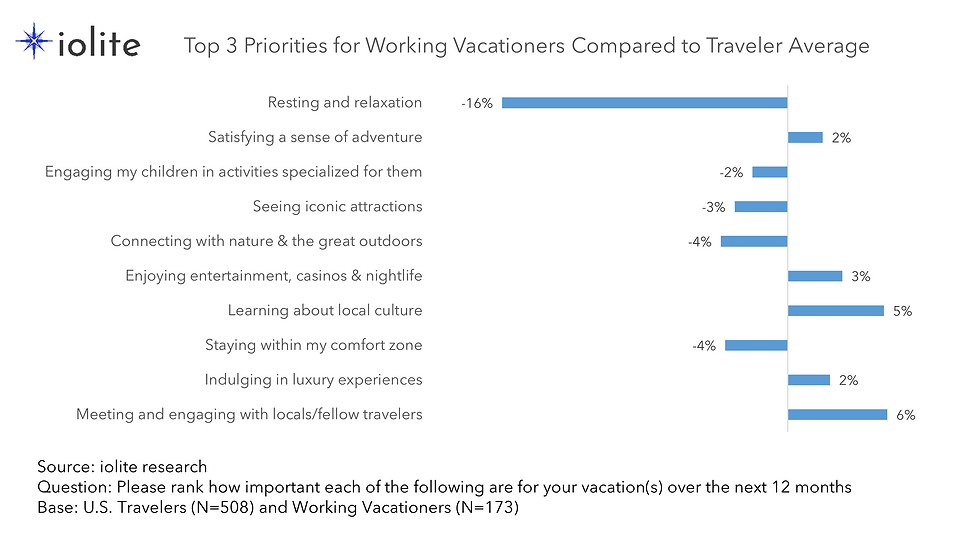U.S. Traveler Trends Part 3: The Working Vacation Emerges as a Mainstream Phenomenon
- Carroll Rheem

- Aug 24, 2021
- 4 min read
In the wake of COVID-19 and humanity’s continued battle to contain it, companies across industries have been forced to reimagine their office work policies. Many are making permanent changes to become at least more flexible, if not entirely virtual. According to iolite research [1], this newfound freedom to roam while still on the clock has paved the way for a new type of trip, and over 30 million American households plan to partake. Will working vacations be occasional, or is the digital nomad lifestyle really becoming a thing? How do working vacationers differ in priorities and how can destinations attract them?

Blurred Lines
Americans have long been known for being work-obsessed – commonly not taking their paid vacation days and unwilling to leave their work laptop behind when they do get away. At the same time, many business travelers have gotten accustomed to adding a bit of leisure to work trips, whether it’s a night out on the town or a full weekend add-on. For many, the freedom to work from anywhere has made the line disappear altogether to create a different trip category – the working vacation. Of course, it wasn’t unheard of before the pandemic, but the working vacation has now grown into a significant category. Sixteen percent (equivalent to 33 million) of U.S. households plan at least one (including flights and/or paid lodging) in the next 12 months. Among the traveling population (adults who will take at least one vacation including flights and/or paid lodging in the next 12 months), the percentage more than doubles to 34%.

A Cross-Generational Sweet Spot
As you might expect, younger travelers are more likely to take working vacations in general, but the relationship is not linear, as 35-44 year-olds (51%) are the most likely to take one. This peak age group transcends a generational line and is substantially more likely to take a working vacation compared to its component generations’ averages – millennials (43%) and Gen X (35%). This age group is a sweet spot for working vacations as its members are the most likely to have a combination of income (means), wanderlust (motive) and professional positions that allow them to work remotely (opportunity). Younger millennials and Gen Y are less likely to have the means and opportunity, while older Gen X and boomers are less likely to have the motive.
One off or Way of Life?
Taking PTO is still the plan for most travelers as 66% of U.S. travelers do not plan to work standard hours on any of their vacations this year. Among those who do plan to take working vacations, the majority (69%) only plan to take one or two in the next 12 months. While the digital nomad lifestyle has undoubtedly become more popular amid flexible work policies and steep housing costs, it is still limited to a very small niche of the traveling population.

Living la Vida Local
Given that work is part of the equation for these trips, travelers going on working vacations have a slightly different set of priorities than the typical vacationer. The chart below shows the variance in the top three ranked vacation priorities between the two groups. The clearest difference is that 16% fewer working vacationers are fixated on rest and relaxation. Instead, they are more interested in sampling local life – culture, entertainment, and locals themselves – which suggests that they approach these trips more as if they are living rather than just vacationing in the destination.

Rather than a remedy for too few PTO days, travelers are more often taking working vacations as a way of sampling what it is like to live in a different place. The natural affinity these travelers have for home rentals rather than hotel rooms only adds to the gains short-term rental companies have achieved during the pandemic. Urban hotels are likely to struggle to capture a piece of this new segment; adapting extended stay suites brands to appeal to younger, trendier working vacationers rather than business travelers may be a good opportunity to reclaim some lost ground.
Marketing Implications
Local lifestyle is at the heart of what motivates most working vacationers to pick their destinations, and very often it means small pleasures – e.g., local foods, a beautiful riverside park, a café with great people watching. Sharing what locals love about their neighborhoods rather than world famous icons will be more effective for this audience. It is not that working vacationers would avoid tours and attractions entirely, but they are not as likely to be motivated by them. Many in this group are urban professionals, excited by the opportunity to feel what it’s like to live somewhere else.
Attracting working vacationers is a slightly different task from attracting vacationers, but it is a segment worth targeting. Their travel patterns are often more flexible, making them ideal for shoulder and off-peak seasons. They tend to have strong interest in local culture, providing the opportunity to showcase small businesses and off the beaten track experiences. While some destinations view short-term rentals as a big concern for overtourism, these travelers are not very likely to seek touristy, crowded areas. Particularly for urban destinations that are reeling from the lack of group and business travel, working vacationers may present a key opportunity for near term recovery. [1] Proprietary iolite research study fielded on June 10, 2021 by Directions Research. Respondents were a demographically representative sample of US adults, N=1,083




Comments